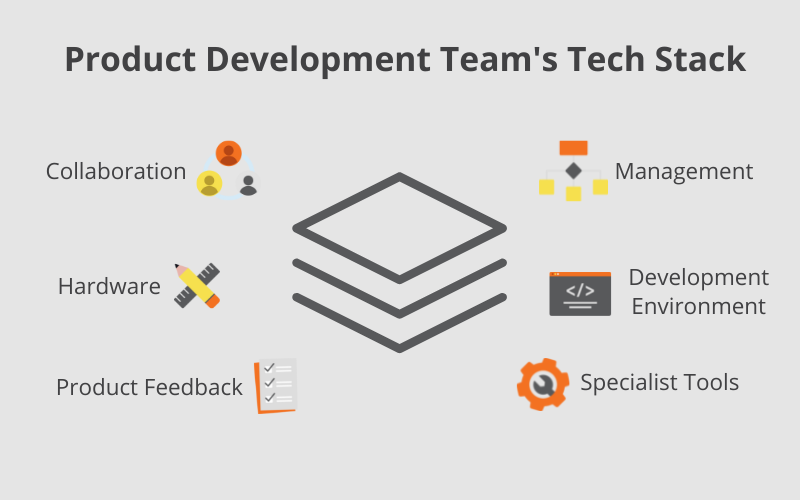
The technology your product development team uses to get work done will have a significant impact on your team’s productivity. The right set of tools, used in the right way, will help the team work better together.
We call these tools – tools that enable, supercharge, or are required for product development – the Product Development Team’s Tech Stack.
The Product Development Team’s Tech Stack consists of these elements:
- Collaboration
- Management
- Hardware
- Development Environment
- Product Feedback
- Specialist Tools
For our purposes in this article, we are just going to cover the categories, their subcategories and some examples. We won’t explore how to use the tools, or which combinations are most effective.
Collaboration
The collaboration tools in your team’s tech stack are those that help you work together more productively. These tools help you communicate in different ways, from brainstorming ideas to urgently resolving a critical issue, right through to capturing lessons learnt.
The subcategories are:
- Email (e.g. Outlook, Gmail)
- Chat (e.g. Slack, Microsoft Teams)
- Virtual Meetings (e.g. Zoom, Google Meet)
- Diagrams (e.g. PowerPoint, Miro, Google Slides, Lucid Chart)
- Documentation (e.g. Google Docs, Word, Confluence)
Management
The management tools in your team’s tech stack are the tools that help you, your team’s leader(s), and key stakeholders manage the work of the team. These tools help you manage tasks and individual workloads, but also let you take a broader perspective, looking at deliverables, timelines, dependencies and more.
The subcategories of management tools are:
- Task management (e.g. Asana, Jira, Trello)
- Project management (e.g. Microsoft Project, SmartSheet, Excel)
- Reporting (e.g. Google Sheets, PowerBI, PowerPoint)
Hardware
The hardware your team uses has a material impact on productivity.
Hardware is often forgotten, perhaps because it sits outside the control of many team leaders, yet it has an oversized bearing. A slow laptop will just make using every other part of the team’s tech stack frustrating and problematic. An extra monitor can enable someone to work more easily ‘in the zone’.
The subcategories of hardware are:
- Monitors
- Devices (e.g. Laptops, Smartphones, tablets)
- Chairs
- Accessories (e.g. keyboards, mice, docking stations)
Development Environment
The development environment of your team is where, for a product development team, the ultimate deliverable is created. Because the development environment is the ultimate end-place for the work of product development teams, it has a special bearing on team productivity. Remember, it has to be about shipping working software.
All the productivity gains in other areas of the team’s tech stack would be for nothing if the development environment has issues or isn’t aligned. On the other hand, tight integration between the non-development elements of the team’s tech stack and the development environment can significantly lift the productivity of engineers and the team overall.
The subcategories of the Development Environment most relevant to the team’s perspective are:
- Coding Tools (e.g. IDE, Linting)
- Repository (e.g. GitHub, TFS, GitLab, BitBucket)
- Sandbox Environment (e.g. an AWS, Azure or GCP environment engineers can experiment in)
- Testing (e.g. Excel)
Product Feedback
The subcategories are:
- Product Analytics (e.g. Mixpanel, Heap, Amplitude)
- Error Logging (e.g. Sentry, Crashalytics)
- Datawarehouse (e.g. MySQL, MSSQL, Postgres)
Specialist Tools
Specialist tools are those that individual specialists within the team need in order to be productive. UX Researchers, Designers, Product managers, and Subject Matter Experts (SMEs) all have specific tools that they need to be effective.
Summary
A Product Development Team’s Tech Stack is made up of the tools and infrastructure that teams need to be productive. In the above article, I’ve simply identified the key categories and subcategories for creating collaborative teams, with special emphasis placed on the Development Environment.

Scott Middleton
CEO & Founder
Scott has been involved in the launch and growth of 61+ products and has published over 120 articles and videos that have been viewed over 120,000 times. Terem’s product development and strategy arm, builds and takes clients tech products to market, while the joint venture arm focuses on building tech spinouts in partnership with market leaders.
Twitter: @scottmiddleton
LinkedIn: linkedin.com/in/scottmiddleton